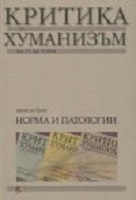РЕПРЕЗЕНТАЦИИТЕ НА ФАШИЗМА В РОМАНИТЕ НА ДЕЛИЛО И ТУРНИЕ ПРЕЗ ПОГЛЕДА НА ЕКЗИСТЕНЦИАЛНАТА СЕМИОТИКА
REPRESENTATIONS OF FASCISM IN DON DELILLO'S WHITE NOISE AND MICHEL TOURNIER’S LE ROI DES AULNES THROUGH THE EYES OF EXISTENTIAL SEMIOTICS
Author(s): Elena AlexievaSubject(s): Literary Texts
Published by: Фондация за хуманитарни и социални изследвания - София
Keywords: fascism; literature; dynamics of sign; semiotic
Summary/Abstract: The present article does not offer a comparative analysis of the two novels, DeLillois White Noise and Tournieris Le roi des aulnes. Rather, it attempts to reveal how, with the use of the existential-semiotic model, the representations of fascism in both works turn out to be part and parcel of the life projects of their characters. This situation, paradoxical as it might seem, deserves a careful semiotic reading since in both cases the specific and original representations of fascism support the very idea of survival, that is, they appear as important fragments of the world and milestones in building the relations between individual and environment. To this end, the concept of existential semiotics is employed, as developed by Eero Tarasti. It allows to follow closely the dynamics of sign in both novels, and thus, to observe the extreme cases of signification they exemplify. Therefore, while Le roi is saturated with an apocalyptic feeling in the face of the freely floating symbol, where the signifier becomes attached to numerous arbitrary signifieds and the roles of signifier and signified are reversed, White Noise goes even further in suggesting a situation of “abandoned meanings” (in DeLillois own phrasing), in which meaning itself is rendered impossible. In both novels representations of fascism, in the broadest sense, are the ones which illustrate these processes. Existential semiotics, on the other hand, provides the relevant standpoint and instruments that enable a dynamic rather than static approach - one of its major advantages compared to classical semiotics.
Journal: Критика и хуманизъм
- Issue Year: 2004
- Issue No: 17
- Page Range: 155-170
- Page Count: 16
- Language: Bulgarian
- Content File-PDF

